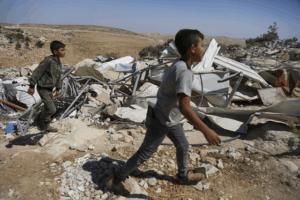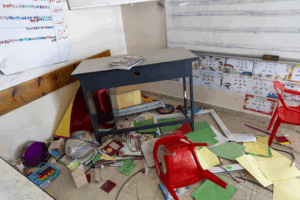In a West Bank ‘firing zone’ Palestinians are erased as settlers lay down roots

Palestinian children walk through rubble following Israeli army demolitions in the village of Khalet al-Daba, Masafer Yatta, southern West Bank, 18 September 2025
Basel Adra reports in +972 on 27 October 2025:
Ever since settlers from the Mitzpe Yair outpost first descended on the village of Tabaqat al-Jundi in Masafer Yatta in November 2021, Jamil Al-Amour’s family has endured relentless harassment and violent attacks.
That month, they shot and wounded Al-Amour’s son and another relative, and set fire to the family’s agricultural shed. They have returned repeatedly since then, often accompanied by Israeli soldiers, to demolish the rebuilt structure, uproot olive saplings, and graze their livestock on the family’s land. During this time, they also expanded the outpost they’ve been building on the village’s property; by 2024, it included a sheep pen, tents, solar panels, and several caravans.
Officially, the settlers are not permitted to be in this area. Tabaqat al-Jundi is one of 12 Palestinian communities located within what the Israeli army designates as “Firing Zone 918,” a military training zone officially closed to both Palestinians and Israelis. Yet while Palestinians are routinely barred from building or even entering the area, settlers continue to establish and expand outposts there with complete impunity.

Damage to a classroom following a large-scale attack by Israeli settlers and soldiers, in the village of Jinba, Masafer Yatta, southern West Bank, 3 April 2025
In August 2025, settlers marked a new phase of their entrenchment in the firing zone. In broad daylight, they used concrete pumps and cement mixers to lay foundations for a permanent structure in Tabaqat al-Jundi. Despite the work being illegal even under Israeli law, they faced no interference from the army or police.
As settlers worked around the clock in Tabaqat al-Jundi, Israeli army bulldozers descended on the nearby village of Khalet al-Daba, which also lies within Firing Zone 918. Since May, Israeli forces have raided the village multiple times, reducing most of it to rubble. Today, no houses remain, and only a few makeshift tents offer residents scant protection from the coming winter.
